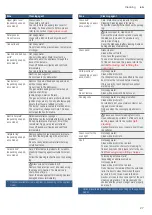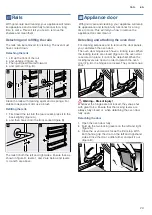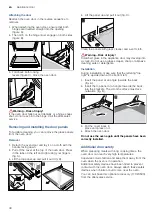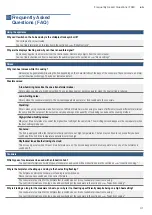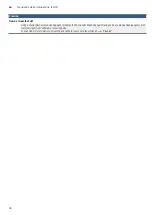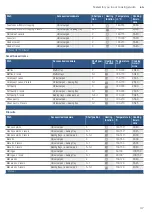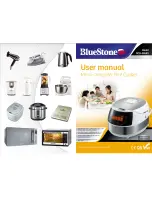
en
Tested for you in our cooking studio
40
Shiny roasting dishes made from stainless steel or
aluminium reflect heat like a mirror and are therefore
not particularly suitable. The poultry, meat and fish
cooks slower and does not brown so well. Use a higher
temperature and/or a longer cooking time.
Observe the manufacturer's instructions for your
roasting cookware.
Uncovered cookware
To cook poultry, meat and fish, it is best to use a deep
roasting tin. Place the tin onto the wire rack. If you do
not have any suitable cookware, use the universal pan.
Covered cookware
When cooking with covered cookware, the cooking
compartment remains considerably cleaner. Ensure that
the lid fits well and closes properly. Place the cookware
onto the wire rack.
Poultry, meat and fish can also become crispy in a
covered roasting dish. Simply use a roasting dish with a
glass lid and set a higher temperature.
Grilling
Keep the appliance door closed when using the grill.
Never grill with the appliance door open.
Place the food to be grilled on the wire rack. In addition,
slide the universal pan in at least one shelf position
lower, with the slanted edge facing the appliance door.
Any dripping fat will be caught.
When grilling, try wherever possible to use pieces of
food which are of a similar thickness and weight. This
will allow them to brown evenly and remain succulent
and juicy. Place the food to be grilled directly onto the
wire rack.
Use tongs to turn the pieces of food you are grilling. If
you pierce the meat with a fork, the juices will run out
and it will become dry.
Do not add salt to the meat until it has been grilled. Salt
draws water from the meat.
Notes
■
The grill element switches itself on and off
repeatedly; this is normal. The grill setting
determines how frequently this occurs.
■
Smoke may be produced when grilling.
■
When you are using the grill, do not insert the baking
tray or universal pan into the cooking compartment
any higher than shelf position 3. The high
temperatures at the top of the cooking compartment
can warp accessories, which may damage the
cooking compartment when removed.
Meat thermometer
Depending on your appliance's features, you may have
a meat thermometer. You can cook accurately using a
meat thermometer. Read important notes on using the
meat thermometer in the corresponding chapter. There,
you can find notes on inserting the meat thermometer,
the possible heating types and additional information.
Recommended setting values
The setting values are based on the assumption that
unstuffed, chilled, ready-to-roast poultry, meat or fish is
placed into a cold cooking compartment.
In the table, you can find specifications for poultry, meat
and fish with default values for the weight. If you wish to
prepare heavier poultry, meat or fish, always use the
lower temperature. If roasting several joints, use the
weight of the heaviest piece as a basis for determining
the cooking time. The individual pieces should be
approximately equal in size.
The larger the poultry, meat or fish is, the lower the
cooking temperature and the longer the cooking time.
Turn the poultry, meat and fish after approx.
^
to
Z
of
the indicated time.
Poultry
When cooking duck or goose, pierce the skin on the
underside of the wings. This allows the fat to run out.
If using duck breast, score the skin. Do not turn duck
breasts.
Add some liquid to the poultry in the dish. Cover the
base of the ovenware with approx. 1-2 cm of liquid.
When you turn poultry, ensure that the breast side or
the skin side is underneath at first.
Poultry will turn out particularly crispy and brown if you
baste it towards the end of the roasting time with butter,
salted water or orange juice.
Meat
Baste lean meat with fat as required or cover it with
strips of bacon.
When roasting, add a little liquid if the meat is lean. A
covering of approx.
^
cm depth should be applied to
the base of any glass cookware.
Score the rind crosswise. If you turn the joint when
cooking, ensure that the rind is underneath at first.
When the joint is ready, turn off the oven and allow it to
rest for another 10 minutes in the cooking
compartment. This allows the meat juices to be better
distributed. Wrap the joint in aluminium foil if necessary.
The recommended resting time is not included in the
cooking time indicated.
It is more convenient to roast and braise meat in
cookware. You can take the joint out of the cooking
compartment more easily in the cookware, and prepare
the sauce in the cookware itself.
The quantity of liquid is dependent on the type of meat,
the cookware material and also on whether or not a lid
is used. If preparing meat in an enamelled or dark metal
roasting dish, it will need a little more liquid than if
cooked in glass cookware.
The steam evaporates in the cookware when roasting.
Carefully pour in more liquid if required.
The distance between the meat and the lid should be at
least 3 cm. The meat may rise.
If necessary, braise the meat first by searing it. Add
water, wine, vinegar or a similar liquid to the braising
liquid. A covering approx. 1-2 cm deep should be
applied to the base of the cookware.


